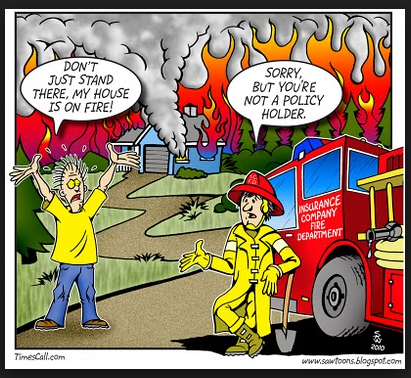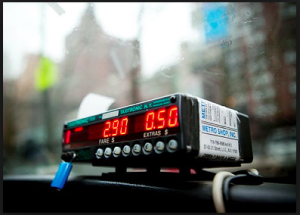In our trading system, we earn money three ways: like an INSURANCE COMPANY, and like a TAXI DRIVER, and like a RETAIL STORE.
Regardless of which stocks we use, or whether we invest in Puts or Calls, the same methods apply.
1. Time Decay ....the Insurance Company Way
Insurance companies sell policies, collect premiums, and then wait for monthly and annual policies to expire. They profit by the erosion action of time. The insurance giants collect millions of dollars from customers and hold them as surety against future claims. You can't go back and make a claim on a loss unless you've first paid in. Each year that premium income exceeds claims, the company declares a profit.
In the same way, we collect option premium and hold it until it expires. At that point, it is booked as profit.
Sellers of premium take on the risk that others avoid. Healthcare and life insurance companies keep adjusting prices so they can assure themselves a profit. In a similar way, every month, the exchange computers calculate the risk of a downturn in the stock market and issue a nominal value to stock options. The system therefore is rigged to favor sellers of options over buyers, as the cost of premium is borne by option buyers.
When we sell Puts and Calls, we expect their value to go down, hopefully to zero. As we are first sellers of positions, we wait until the value of an option drops or expires, and the difference is our profit. By selecting and selling options far from the current price, we have a high probability of their expiring worthless.
It is up to the trader to decide the best way to sell premium around a particular stock, or you can sell Puts and Calls on large indexes such as the SPY or SPX. If the price is going up, we sell Puts. If the price is going down, we sell Calls. Sometimes we can sell both at the same time, increasing returns. Even if the price of the stock does not move at all, sellers of options will make money as an option slowly expires.
Time = money!
2. Price Movement -- the Taxi Driver Way
 The taxi moves out from the curb, carrying me to Honolulu International Airport. The driver turns on the meter and the fare starts to pile up. When the taxi gets to the airport, he shuts off the meter and says, "That will be $26.75." I give him $30 and a "mahalo" and he looks for his next customer. Deal done. Movement means money to the driver but time is not the important factor in the taxi business. Unless you don't have a customer, of course!
The taxi moves out from the curb, carrying me to Honolulu International Airport. The driver turns on the meter and the fare starts to pile up. When the taxi gets to the airport, he shuts off the meter and says, "That will be $26.75." I give him $30 and a "mahalo" and he looks for his next customer. Deal done. Movement means money to the driver but time is not the important factor in the taxi business. Unless you don't have a customer, of course!
But are two ways we can make money when stocks move in price, regardless of time. Stock prices change daily, making our positions more or less profitable.
Long Puts and Calls
If we buy Puts or Calls, then we want them to increase in value. The trick is buy then as the prices start to move, often after a reversal, and have a target in mind. When you hit the target, sell the option and keep the profit safe.
EXAMPLE: AAPL is close to $99. The overall market is becoming bearish, and you believe that AAPL will also drop about $5. You buy an in-the-money 105 Put for $6.80. The price drops to $94 at which moment your Put is now worth $10.10. You sell and profit is $3.30.
Credit Spreads
If we first sell Puts and Calls, we want them to decrease in value. As prices move away from our credit spreads, they drop in value, quickly generating profit, which we realize by buying them back at a lower price.
EXAMPLE: When the price of GOOGL is at $551, we sell the 530/525 Put spread for a credit of $1.25. In three days, the price of GOOGL jumps to $578, reducing the price of our spread to $0.78. Even with almost no reduction in time value, we have a profit of $0.47.
Of course, if the price moves toward our credit spreads instead of away, we will see a paper loss. So we put on credit spreads whenever we see the stock starting to move away from, not when it is heading toward, our chosen strikes.
Deep-ITM spreads
The more sophisticated way to trade using directional strategies is to sell deep ITM spreads--Puts or Calls. We can capitalize on moderate price movement with limited risk. We prefer this strategy to buying long puts or calls as we obtain significantly higher deltas and avoid some time decay. As they say, we get "more bang for the buck!"
Movement = money!
3. Rapid Turnover -- the Retail Store Way
 Retail stores make profit by moving their merchandise. During daylight hours, they make lots of small sales. In the dark hours, they restock the inventory, making it easy for customers to select and buy. The same length of shelf space can sell thousands of dollars in many small sales. Their secret is turnover--using the same space to sell over and over and over again.
Retail stores make profit by moving their merchandise. During daylight hours, they make lots of small sales. In the dark hours, they restock the inventory, making it easy for customers to select and buy. The same length of shelf space can sell thousands of dollars in many small sales. Their secret is turnover--using the same space to sell over and over and over again.
As option traders, we usually divide our account into $5,000 nests--think of them as spaces on the store shelf. We generate more profits by selling puts and calls frequently, and then replenishing as fast as we can. The difference between what we sold an option for and the buy back price is our profit. If I can use the same $5,000 investment (margin money) a dozen times in a year, and earn perhaps 5% each time, I make 60% over the year. We can do it at least twelve times a year using monthly options, and more frequently using weeklies. Of course, some months we may not be profitable, just as store may be slow to move items. What we want is turnover, and it's a secret to more profits.
Turnover = money!
So that's three ways we make money: like an insurance company, a taxi driver, a retail store.
JOIN us at meetup.com/honolulu-options-traders
LIKE us at facebook.com/honloluluoptionstraders
-------------------
Copyright © 2014 - 2016 Honolulu Options Traders, LLC.
All rights reserved worldwide.